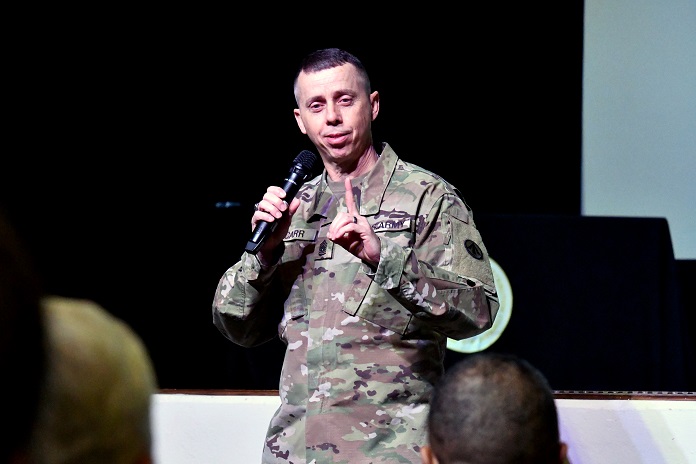
CSM Rocky Carr addresses an audience at HQ,
Military Surface Deployment and Distribution Command
MSG Half-Mast recently traveled to Scott Air Force Base, Illinois, to speak with Command Sergeant Major (CSM) Rocky Carr, the Military Surface Deployment and Distribution Command's (SDDC's) Senior Enlisted Leader.
CSM Carr joined the US Army in 1991 after graduating from Union High School in Clinton, North Carolina. He attended basic and advanced individual training at Fort Jackson, South Carolina. Among his recent senior leader assignments, he has served as: 21st Theater Sustainment Command CSM; 409th Contracting Support Brigade CSM; and CSM for the 115th Brigade Support Battalion, 1st Armored Brigade Combat Team. He assumed his current duties as the 17th Senior Enlisted Leader of the SDDC in December 2019.
MSG Half-Mast: CSM Carr, thank you for taking the time to speak with PS Magazine today. In simple terms, what is the mission of the Military Surface Deployment and Distribution Command and how does your mission impact warfighters?
CSM Carr: The mission of the SDDC is to integrate and synchronize global surface deployment and distribution capabilities to project and sustain the armed forces. In short, we project the Joint Force through all surface transportation nodes via rail, line haul and vessel movements. In regards to impact for the Warfighter, we have the most capable and lethal fighting force in the history of the world, but if we cannot close with the enemy, it doesn’t matter. James Mattis, the 26th Secretary of Defense summed it up best when he said, “If you cannot move, you are not lethal.” Thankfully, we have great partnerships across the force and, together, we deliver the force to the point of need.
MSG Half-Mast: It seems like there are several moving parts to getting warfighters and their equipment to different parts of the world. How does SDDC coordinate with other services to plan and execute missions and what are some of the challenges SDDC encounters in successfully moving large amounts of people and materiel?
CSM Carr: We pride ourselves on synchronization of effort and coordination of planning; these two efforts provide the foundation for developing and validating transportation requirements. Once we have a validated requirement, we leverage our Joint Deployment and Distribution Enterprise (JDDE) partnerships to find the right movement solution for our combatant commanders. Many challenges are often ironed out in the requirement generation process and the remainder are worked by our fantastic transportation brigades that are geographically dispersed around the globe. They are engaged in every theater and combatant command to meet the needs of the warfighter and deliver readiness and lethality to the right place, at the right time, every time.
I would be remiss if I didn’t also mention our great partnership with our reserve component teammates from the Deployment Support Command and what we call our 4th Component—our commercial carriers and partners in industry. They truly are the secret sauce in our strategic depth in capacity and capability. We could not do it without their great effort and commitment.
MSG Half-Mast: How important is properly-conducted PMCS to fulfilling the SDDC mission and what guidance or advice on PMCS would you offer to the young warfighters, of every service, involved in SDDC missions or being supported by SDDC in moving their vehicles and equipment?
CSM Carr: PMCS is the bedrock of equipment readiness. A sound PMCS program not only keeps our Army equipment mission capable, but it also builds trust and confidence in our equipment from the operator level up. Our Soldiers know that when called upon, the equipment that they maintain will serve them well in a contingency. A good maintenance program with robust PMCS discipline is, in a way, a “warranty” for commanders to deploy, train and fight with confidence.
MSG Half-Mast: You have a deep and diverse background in supply and logistics. What advice do you have to young logisticians and maintainers who aspire to reach your level of leadership?
CSM Carr: First, I encourage every logistician to become an expert in their chosen field, while also gaining an understanding of the broader sustainment enterprise. Our concept of support relies on a team-of-teams, and we are all nested under the U.S. Army Materiel Command to provide support. Second, and just as important, is to take care of your people. Your promotions, accolades and advancements will take care of themselves if you take care of your troops.
In fact, when given the opportunity to talk to Soldiers, I encourage the following:
1: Build and maintain a climate of dignity and respect. Try to make that an integral part of your leadership style.
2: Establish and maintain standards and discipline. We are the United States Army and our standards and discipline are admired around the world.
3: Try to view Soldier issues through a lens of compassion. Never forget that we are in the people business and our Soldiers count on us for help.
4: Lead from a good place in your heart. Frame your approach, priorities, and decisions from an aspect of Soldier care. Our Soldiers and their Families are so worth the effort.
5: Be a leader of presence. Your presence transcends where you are physically. Your presence will be felt by your level of preparedness and detail, even when you are not there. However, when you get a chance to be physically present, be there. Your leadership presence and physical presence are both cherished by Soldiers.